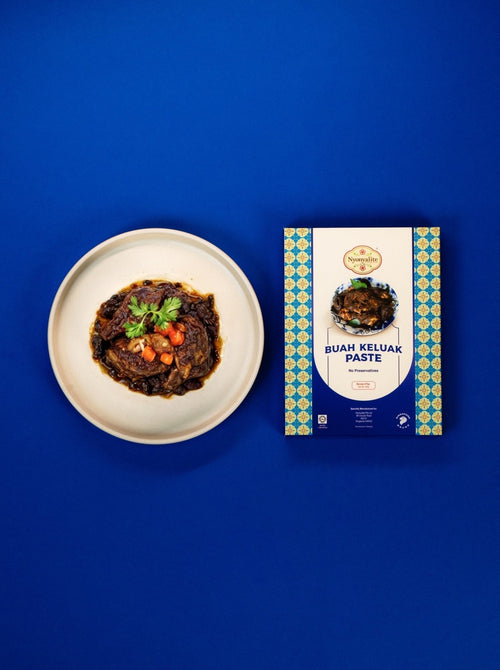满$35即享免费配送。
Buah keluak, often referred to as the "black gold" or :black diamond: of Peranakan cooking, is a unique ingredient treasured for its rich, earthy, and nutty flavor. It plays a starring role in dishes like Ayam Buah Keluak, an iconic dish in Nyonya food. But what makes buah keluak so special is the fascinating transformation it undergoes—from a toxic seed in the wild to a delicious, edible treasure used in traditional Peranakan cuisine. In this article, we’ll take a deep dive into how buah keluak is harvested and cured, making it safe for consumption and perfect for Nyonya dishes.
Harvesting Buah Keluak: From the Tropical Rainforest to the Kitchen
Buah keluak comes from the Pangium edule tree, which grows in the tropical rainforests of Southeast Asia, particularly in regions like Indonesia, Malaysia, and Singapore. This towering tree bears large fruits containing seeds, or "nuts," which are highly valued in Peranakan cooking. However, these seeds are initially toxic, containing high levels of hydrogen cyanide, making them inedible in their raw form.
Once the fruits ripen and fall to the forest floor, they are gathered by hand. The seeds inside, while precious, need to undergo a special curing process to remove their natural toxins and make them safe for consumption. This process is both time-intensive and essential for unlocking the unique flavor of buah keluak that is cherished in Nyonya food.
The Curing Process: How Buah Keluak Becomes Edible
Turning buah keluak from a poisonous nut into a culinary delight is an art that has been passed down through generations in Peranakan culture. Here’s how the process works:
-
Soaking in Water: The first step in curing buah keluak involves soaking the seeds in water for several days, sometimes up to two weeks. This helps to leach out some of the toxins. The water is regularly changed to ensure the removal of the harmful hydrogen cyanide.
-
Burying in Volcanic Ash: After soaking, the seeds are traditionally buried in volcanic ash, a crucial step in the fermentation process. Volcanic ash is rich in minerals, which aid in neutralizing the cyanide, while also enhancing the flavor of the seeds. This step is important because it not only detoxifies the seeds but also imparts a distinctive, earthy flavor that is essential to dishes like Ayam Buah Keluak.
-
Fermentation in Mud or Regular Ash: In other regions, the seeds are buried in mud or ash to continue the fermentation process. Fermentation helps break down the cyanide and creates the signature deep, black color and intense umami flavor that makes buah keluak so unique in Peranakan cooking.
-
Sun Drying: Once fermentation is complete, the seeds are laid out to dry under the sun. This final drying step further ensures that the toxins have been neutralized and the seeds are safe to eat. The drying process also hardens the outer shell, which will later be cracked open to access the edible kernel.
Buah Keluak: The Soul of Ayam Buah Keluak and Peranakan Cuisine
The entire curing process allows buah keluak to develop its signature flavor profile, which is both complex and distinct. The result is a nutty, slightly bitter taste with earthy undertones that pairs beautifully with the bold spices commonly found in Nyonya food. In Ayam Buah Keluak, the buah keluak paste is simmered with chicken and a variety of aromatic spices, creating a rich, savory dish that is deeply satisfying.
Why Buah Keluak Is Essential to Peranakan Cooking
Buah keluak is not just an ingredient; it’s a key part of the Peranakan cooking tradition. The labor-intensive curing process and the distinct flavor it imparts make it a true culinary treasure. Whether you’re enjoying the traditional Ayam Buah Keluak or experimenting with modern takes on Nyonya food, buah keluak brings an authentic and unmistakable depth to every dish.
By the time this special ingredient reaches your plate, it has undergone a remarkable transformation. From being a toxic seed found in the wild to becoming the flavorful core of Peranakan dishes, buah keluak truly represents the heart of Nyonya food. Its presence in Peranakan cooking is a testament to the tradition, patience, and skill passed down through generations of Nyonya chefs.












